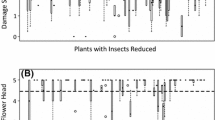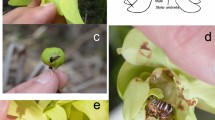Abstract
Floral herbivores and pollinators are major determinants of plant reproduction. Because interaction of floral herbivores and pollinators occurs when herbivores attack the flowers in the bud and flower stages and because the compensatory ability of plants is known to differ according to the timing of herbivory, the effects of herbivory may differ according to its timing. In this study, we investigated the effects of floral herbivory at different stages on fruit production and seed/ovule ratio at two sites of large populations of the perennial herb, Iris gracilipes for 2 years. Herbivory at the bud and fruit stages both tended to have negative effects on fruit production, but the former caused more severe damage. On the other hand, herbivory at the flower stage tended not to have negative effects on fruit production because the degree of flower loss was smaller in the flower stage. Although herbivory decreased fruit production, flowers did not compensate for the damage by increasing the seed/ovule ratio because reproduction of I. gracilipes was limited by pollen availability rather than resources. These results indicate that floral herbivory at different stages has different effects on plant reproduction.





Similar content being viewed by others
References
Aluri RJS (1992) Natural pollination and fruiting limitation in Hyptis suaveolens as a function of predation of lynx spider on pollinators and florivory by katydid. Proc INSA B Biological Sciences 58:201–206
Andersson S (2005) Floral costs in Nigella sativa (Ranunculaceae): compensatory responses to perianth removal. Am J Bot 92:279–283. doi:10.3732/ajb.92.2.279
Ayre DJ, Whelan RJ (1989) Factors controlling fruit set in hermaphroditic plants: studies with the Australian proteaceae. Trends Ecol Evol 4:267–272. doi:10.1016/0169-5347(89)90197-3
Bates D (2007) lme4: linear mixed-effects models using S4 classes. R package version 0. pp 99875–99879
Bertness MD, Shumway SW (1992) Consumer driven pollen limitation of seed production in marsh grasses. Am J Bot 79:288–293. doi:10.2307/2445017
Breedlove DE, Ehrlich PR (1968) Plant-herbivore coevolution: Lupines and Lycaenids. Science 162:671–672. doi:10.1126/science.162.3854.671
Brody AK, Mitchell RJ (1997) Effects of experimental manipulation of inflorescence size on pollination and pre-dispersal seed predation in the hummingbird-pollinated plant Ipomopsis aggregata. Oecologia 110:86–93. doi:10.1007/s004420050136
Cariveau D, Irwin RE, Brody AK, Garcia-Mayeya LS, von der Ohe A (2004) Direct and indirect effects of pollinators and seed predators to selection on plant and floral traits. Oikos 104:15–26. doi:10.1111/j.0030-1299.2004.12641.x
Dugal Wallace D, O’Dowd DJ (1989) The effect of nutrients and inflorescence damage by insects on fruit-set by Banksia spinulosa. Oecologia 79:482–488. doi:10.1007/BF00378665
Ehrlen J (1992) Proximate limits to seed production in a herbaceous perennial legume, Lathyrus Vernus. Ecology 73:1820–1831. doi:10.2307/1940033
Ehrlen J (1996) Spatiotemporal variation in predispersal seed predation intensity. Oecologia 108:708–713. doi:10.1007/BF00329046
English-Loeb GM, Karban R (1992) Consequences of variation in flowering phenology for seed head herbivory and reproductive success in Erigeron Glaucus (Compositae). Oecologia 89:588–595
Faraway JJ (2006a) Binomial data. Extending the linear model with R. Chapman & Hall/CRC, pp 25–54
Faraway JJ (2006b) Mixed effect models for nonnormal responses. Extending the linear model with R. Chapman & Hall/CRC, pp 201–210
Garrish RS, Lee TD (1989) Physiological integration in Cassia fasciculata Michx.: inflorescence removal and defoliation experiments. Oecologia 81:279–284
Gomez JM (2003) Herbivory reduces the strength of pollinator-mediated selection in the Mediterranean herb Erysimum mediohispanicum: consequences for plant specialization. Am Nat 162:242–256. doi:10.1086/376574
Gomez JM (2005) Non-additive effects of herbivores and pollinators on Erysimum mediohispanicum (Cruciferae) fitness. Oecologia 143:412–418. doi:10.1007/s00442-004-1809-7
Hainsworth FR, Wolf LL, Mercier T (1984) Pollination and pre-dispersal seed predation: net effects on reproduction and inflorescence characteristics in Ipomopsis aggregata. Oecologia V63:405–409. doi:10.1007/BF00390673
Hendrix SD (1979) Compensatory reproduction in a biennial herb following insect defloration. Oecologia 42:107–118
Herrera CM (1993) Selection on floral morphology and environmental determinants of fecundity in a hawk moth-pollinated violet. Ecol Monogr 63:251–275. doi:10.2307/2937101
Herrera CM (2000) Measuring the effects of pollinators and herbivores: evidence for non-additivity in a perennial herb. Ecology 81:2170–2176
Herrera CM, Medrano M, Rey PJ, Sanchez-Lafuente AM, Garcia MB, Guitian J et al (2002) Interaction of pollinators and herbivores on plant fitness suggests a pathway for correlated evolution of mutualism- and antagonism-related traits. Proc Natl Acad Sci USA 99:16823–16828. doi:10.1073/pnas.252362799
Holland JN, Bronstein JL, DeAngelis DL (2004) Testing hypotheses for excess flower production and low fruit-to-flower ratios in a pollinating seed-consuming mutualism. Oikos 105:633–640. doi:10.1111/j.0030-1299.2004.13058.x
Ishii H, Morinaga S-I (2005) Intra- and inter-plant level correlations among floral traits in Iris Gracilipes (Iridaceae). Evol Ecol 19:435–448. doi:10.1007/s10682-005-0896-1
Ishii HS, Sakai S (2001) Implications of geitonogamous pollination for floral longevity in Iris gracilipes. Funct Ecol 15:633–641. doi:10.1046/j.0269-8463.2001.00560.x
Juenger T, Bergelson J (2000) The evolution of compensation to herbivory in scarlet gilia, Ipomopsis aggregata: herbivore-imposed natural selection and the quantitative genetics of tolerance. Evolution 54:764–777
Karban R, Strauss SY (1993) Effects of herbivores on growth and reproduction of their perennial host, Erigeron glaucus. Ecology 74:39–46. doi:10.2307/1939499
Kimura T, Ishii HS, Sakai S (2002) Selfed-seed production depending on individual size and flowering sequence in Iris gracilipes (Iridaceae). Can J Bot 80:1096–1102. doi:10.1139/b02-100
Krupnick GA, Weis AE (1999) The effect of floral herbivory on male and female reproductive success in Isomeris arborea. Ecology 80:135–149
Krupnick GA, Weis AE, Campbell DR (1999) The consequences of floral herbivory for pollinator service to Isomeris arborea. Ecology 80:125–134
Lehtila K, Strauss SY (1997) Leaf damage by herbivores affects attractiveness to pollinators in wild radish, Raphanus raphanistrum. Oecologia 111:396–403. doi:10.1007/s004420050251
Lehtila K, Strauss SY (1999) Effects of foliar herbivory on male and female reproductive traits of wild radish, Raphanus raphanistrum. Ecology 80:116–124
Leimu R, Syrjanen K, Ehrlen J, Lehtila K (2002) Pre-dispersal seed predation in Primula veris: among-population variation in damage intensity and selection on flower number. Oecologia 133:510–516. doi:10.1007/s00442-002-1049-7
Louda SM (1989) Differential predation pressure: a general mechanism for structuring plant communities along complex environmental gradients? Trends Ecol Evol 4:158–159. doi:10.1016/0169-5347(89)90118-3
Louda SM, Potvin MA (1995) Effect of inflorescence-feeding insects on the demography and lifetime fitness of a native plant. Ecology 76:229–245. doi:10.2307/1940645
Lowenberg GJ (1994) Effects of floral herbivory on maternal reproduction in Sanicula arctopoides (Apiaceae). Ecology 75:359–369. doi:10.2307/1939540
McCall AC (2007) Leaf damage and gender but not flower damage affect female fitness in Nemophila menziesii (Hydrophyllaceae). Am J Bot 94:445–450. doi:10.3732/ajb.94.3.445
McCall AC, Irwin RE (2006) Florivory: the intersection of pollination and herbivory. Ecol Lett 9:1351–1365. doi:10.1111/j.1461-0248.2006.00975.x
Mothershead K, Marquis RJ (2000) Fitness impacts of herbivory through indirect effects on plant-pollinator interactions in Oenothera macrocarpa. Ecology 81:30–40
Ohashi K, Yahara T (2000) Effects of flower production and predispersal seed predation on reproduction in Cirsium purpuratum. Can J Bot 78:230–236. doi:10.1139/cjb-78-2-230
Paige KN (1992) Overcompensation in response to mammalian herbivory: from mutulastic to antagonistic interactions. Ecology 73:2076–2085. doi:10.2307/1941456
Pettersson MW (1991) Flower herbivory and seed predation in Silene vulgaris (Caryophyllaceae): effects of pollination and phenology. Ecography 14:45–50. doi:10.1111/j.1600-0587.1991.tb00632.x
Pilson D, Decker KL (2002) Compensation for herbivory in wild sunflower: response to simulated damage by the head-clipping weevil. Ecology 83:3097–3107
R Development Core Team (2008) R: a language and environment for statistical computing. R Foundation for Statistical Computing, Vienna, Austria
Riba-Hernandez P, Stoner KE (2005) Massive destruction of Symphonia globulifera (Clusiaceae) flowers by central American spider monkeys (Ateles geoffroyi). Biotropica 37:274–278. doi:10.1111/j.1744-7429.2005.00037.x
Russell FL, Louda SM (2005) Indirect interaction between two native thistles mediated by an invasive exotic floral herbivore. Oecologia 146:373–384. doi:10.1007/s00442-005-0204-3
Schemske DW, Horvitz CC (1988) Plant-animal interactions and fruit production in a neotropical herb: a path analysis. Ecology 69:1128–1137. doi:10.2307/1941267
Stephenson AG (1981) Flower and fruit abortion: proximate causes and ultimate functions. Annu Rev Ecol Syst 12:253–279. doi:10.1146/annurev.es.12.110181.001345
Strauss SY, Conner JK, Rush SL (1996) Foliar herbivory affects floral characters and plant attractiveness to pollinators: Implications for male and female plant fitness. Am Nat 147:1098–1107. doi:10.1086/285896
Acknowledgments
The authors wish to thank Satoshi Chiba for reading an early version of this paper; Onno Muller for improving the English and helpful comments; Tohru Nakashizuka, Kouki Hikosaka, Shimpei Oikawa, Tomoyuki Itagaki, Hisashi Tsujisawa, Yuka Suzuki, and Yuka Uchino for their valuable suggestions; Yasuhiko Konno for identifying the floral herbivore; and Jun Yokoyama and Noriyuki Osada for advice on identifying floral herbivores.
Author information
Authors and Affiliations
Corresponding author
Rights and permissions
About this article
Cite this article
Oguro, M., Sakai, S. Floral herbivory at different stages of flower development changes reproduction in Iris gracilipes (Iridaceae). Plant Ecol 202, 221–234 (2009). https://doi.org/10.1007/s11258-008-9461-7
Received:
Accepted:
Published:
Issue Date:
DOI: https://doi.org/10.1007/s11258-008-9461-7




